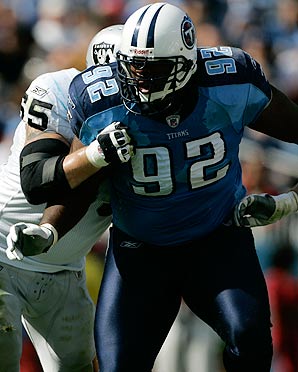Strategic planning: How teams should prepare for uncapped year
Operating without a salary cap, pundits will tell you, will cause mass chaos in the market and the deep-pocketed owners will build huge payrolls, stopping at no cost to buy a Super Bowl winner.
I suppose that a scant few owners could try that approach, but the more likely scenario is that with no forced minimum spending, an overwhelming majority of owners -- if not all -- will impose their own cap, which will be well below the minimum that the current CBA demands. Given that scenario, allow me to tell you how things will really go down.
I would assume each owner in the NFL called two meetings this week: One with his finance people, getting their numbers in order for whatever may happen and playing out every possible financial scenario; the other with his general manager, instructing him to put in place a comprehensive plan for dealing with the upcoming changes on the football side.
Before I get into my plan of what I would do as GM once leaving that meeting, we have to assume the following:
• The players association will decertify as a union. This decertification may prevent a work stoppage and insure that the NFL will definitely operate without a cap for the 2010 season.• The head coach's job is not in jeopardy. It is critical to show the entire staff the three-year plan, letting them know they will be a vital part of making this work. • Veteran players with a prolific injury history will be virtually unsignable. The worker compensation liability in the United States today is very expensive. And when you sign an injured older player, you become exposed to paying large sums of money that is not accounted for in the salary cap. And we need to build a little war chest. • Our owner will impose some type of internal cap -- probably well below the current number -- for salary and benefits.
Here is my five-part plan for preparing for an uncapped season:
My first priority will be to develop a list of players that I would call irreplaceable players. These are players from our team, that may be in the top 10 at their position in the NFL and, most importantly, at a position that impacts the game on third down. Guys who fit this criteria include Titans defensive tackle Albert Haynesworth, Jaguars safety Reggie Nelson and Panthers defensive tackle Damione Lewis. From this list I will make sure the players in this category are all under contract for the 2010 season. These players would be untouchable for trades. If I don't have a quarterback on this list, then every day for the next 24 months would be spent finding a way to accomplish this goal.
My second list would consist of players that I call replaceable players. Most of these players are backups; they may add some value to the team today, but will be too expensive in an uncapped year. (Yes, too expensive. I'll explain more about that later.) So all the players from this list would be on my trading block right now. Players who fit this criteria: Cowboys safety Roy Williams, Broncos running back Travis Henry and Ravens running back Willis McGhee.
It's from this list of replaceable players that most teams poorly waste salary cap dollars by having too many middle level-priced players playing in a backup role. Overspending on replaceable players is the biggest cap sin in football because it prevents a team's ability to invest those dollars into young players for contract extensions. One other benefit of having young, hungry players in backup roles is it improves your special teams talent base.
My goal here is to start working on reducing my replaceable player list with a young and cheaper work force.
Our team will need young players who love the game and are willing to work on and off the field. We are going to invest time and money into these players and need a commitment back from our investment. As a football team, you don't want to be too young or too old; you need age balance on your roster. For the next three years I would be looking to find young players who can fill roles and develop experience in our system, so that in 2010 the team is not too young. I am building a football team that is talent-rich and financially secure going into an uncapped year, so my young players need to be developed.
My pro personnel department would be instructed to evaluate every team in the league -- not only evaluating the pending free agents, but also the entire team, including the practice squad. We are looking for young players -- especially offensive and defensive lineman -- who fit our profile. We will do a comprehensive study of the 2005 and 2006 draft, because in an uncapped year, their free-agent qualifications would move from four years to six. So identifying any young player who may be available from these two drafts that meet our specific position criteria would be a huge bonus. Each day, the personnel department would evaluate the waiver wire looking for ways to improve our roster, from our 45th player to our 53rd player until the right combination of young players were collected. By 2010 our goal would be to have 30 players with three years of service or less on the team.
We will target the personnel of Atlanta, Washington, Baltimore and Miami. These teams will release players because they don't fit their new coaching staff's scheme, but might fit ours. There is always a large player turnover from new coaching staffs and our attention will be on their every move.
Offensive and defensive linemen will be a huge part of the core. The practice squad and final 10 spots of the roster would be devoted to developing these two positions. (When teams in a capped era place restricted tags on backup offensive lineman -- as Cincinnati did with Stacy Andrews and Pittsburgh with Max Starks -- then you know there is a premium for the position.) Our team would have an extra offensive and defensive line coach working in conjunction with the other line coaches to devote countless hours to player development on both lines. Think of this as our farm system of linemen. If we can develop players here, it would give us great flexibility on and off the field.
Because the owners opted out of the CBA last week, the college draft is now set to expire in 2011. So in preparation, the dynamics of how college scouting is implemented will have to be modified. We will have six college scouts assigned to the top 60 colleges that produce the most professional players. Each scout would be responsible for 10 schools, making sure he was on their campus at least three times a month. At these schools, the scout will evaluate every player on the roster, detailing his background, his character, his football acumen. Because of the threat of no draft, we have to know every player inside and out. We cannot control how the new system will operate, but we can control how we prepare.
Our two remaining scouts will be in charge of evaluating the top juniors and seniors of the non-60 schools. Again, they will know each player's background, character and football talent.
The thought of not having a draft is not appealing to me whatsoever, but there has to be an emergency plan in the works. Change is a part of life and the people that respond quickly and efficiently to it will dominate in an ever-evolving world. Changing how we scout colleges would greatly enhance our ability to operate in any new system.
Any player who may become a free agent because of the new system in 2010 would be considered a valuable trading asset -- say the Saints' Reggie Bush and Will Smith. From my replaceable player list, I would try to trade players for draft picks in 2009 and 2010. Our goal would be to acquire as many extra picks before the draft expired in 2011. Drafts picks will be like gold in allowing us to collect young players that best serve our ability to compete for a Super Bowl in an uncapped year.
Where our team finished in the draft order in 2009 and 2010, and the quality of the draft, would determine if I wanted to move up or down in the draft. Having one great player is always better then three average players, so before I made any decisions on what direction I would trade, it would be vital to know the landscape of talent in the current draft.
This is the one area we have to outshine the competitors. Our offseason program would have 100 percent attendance. Having an individual program of development for each player will be our first objective. Our coaches must be willing to work with young players and the front office must be realistic with their evaluation of the young talent. The key to our success will be in our ability to procure and develop players.
---------
By stocking our team's war chest full of good, young talent, and having a solid plan in place for procurement, we would be ready for whatever self-imposed cap number our owner decided. And with the potential of not having a draft in 2011, we would be in position to compete with any team for the rights to the best and brightest college players. Owners will be able to put a solid product on the field and their internal cap will allow them to handle all the debt service of their stadiums and operate with a better profit than this current deal allows.
Starting today, the plan is in place.





